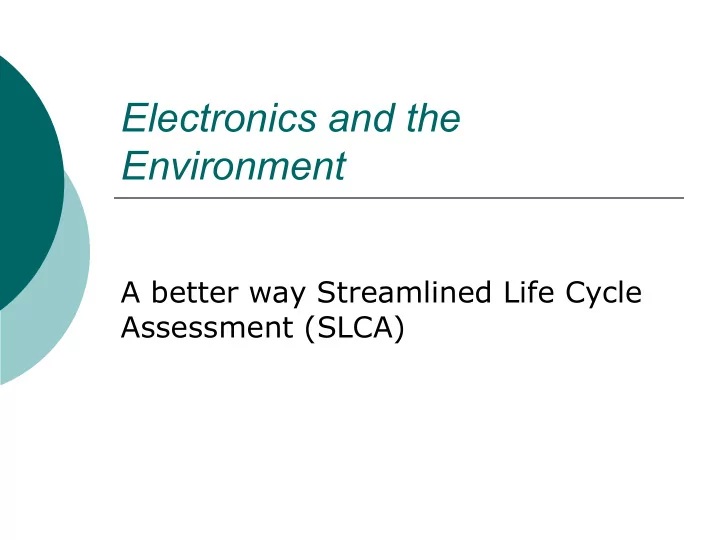

Electronics and the Environment A better way Streamlined Life Cycle Assessment (SLCA)
Outline What about LCA? Why examine SLCA? SLCA Matrix Matrix Scoring Alternative SLCA Matrix Target Plot SLCA: Advantages and Disadvantages Summary
What about LCA? As we have seen previously one way to assess product’s environmental impact is to use a Life Cycle Assessment (LCA), but they can be expensive, time consuming and often limited in their application. Yet, the information gained from thinking indebt about the entire life cycle of a product and all the emissions, material use and energy consumption associated with the product prove to be useful.
Why examine SLCA? SLCA help us understand issues we face in moving towards products with smaller environmental impacts. Streamlined Life Cycle Assessments is a method widely used to preserve the advantages of life cycle assessments and avoid some of the disadvantages. SLCA is quicker and cheaper than doing a full life cycle analysis (LCA) it can reveal approximately 80% of the impacts over the complete life cycle of any product within a short period of time.
Why examine SLCA? SLCA goes about questioning each life cycle stage carefully, while directing it towards the product teams. This help them to think innovatively about challenges for sustainability. It also communicates environmental impacts to non-experts and the progress towards decreasing environmental impacts.
SLCA Matrix In a streamlined life cycle assessment the goal is to maintain a thorough examination of the product life and environmental impacts, while at the same time simplify data collection. In a SLCA we combine life cycle stages into simple categories and environmental impacts into simple categories. This creates a matrix of life cycle impacts and life cycle stages. The goal of the streamlined assessment is to fill in this matrix with information regarding the magnitude of environmental impacts.
SLCA Matrix
SLCA Matrix As can be seen from the matrix we group life cycle stages and group impacts into broad categories in order to establish a matrix of life cycle impacts and life cycle stages One method of summarizing information in the matrix is to assign scores to each of the parts of the matrix.
Matrix Scoring
Matrix Scoring As we can see assign scores range from 0-4 (0=poor performance, 4=excellent performance), the previous example was for the premanufacture stage of the life cycle in the material choice impact category. Graedel and Allenby suggest some criteria for assigning scores. For the example criteria include the extent to which recycled materials are used and whether the materials used are relatively plentiful or scarce. Filling in the entire matrix results in a total of 25 scores, ranging from values decided on. Assigning scores is subjective to the team’s and people’s judgment and there should be documentation for the reasoning behind the scores.
Alternative SLCA Matrix
Alternative SLCA Matrix There are alternative ways that the matrix could be set up. As we have seen that rather then using numbered results for scoring it can be displayed in a colour- coded matrix. However it is important to define the scoring and value set up well.
Target Plot Because the scores can rather subjective, the scores are often used to identify life cycle stages and impact categories that justify consideration. One way of calling attention to areas need it is to display the scores using a target diagram. In this diagram, high scores are plotted near the target, while low scores are shown as off-target.
Target Plot
SLCA: Advantages and Disadvantages The primary advantage of a streamlined life cycle assessment is its simplicity. It considers the entire life cycle and considers multiple impact categories from this output we can identify critical areas of concern. The major disadvantage of the method is that the assignment of scores can seen to be highly subjective to the team’s and people’s judgment.
Summary SLCA quicker and cheaper than a full life cycle analysis (LCA) Can reveals approximately 80% of the impacts over the complete life cycle of any product within a short period of time. Causes product teams to think systemically about a product and gives a way to judge whether or not something has more of an environmental impact or not. Communicates environmental impacts to non- experts. The progress towards decreasing environmental impacts.
Summary In a SLCA we combine life cycle stages and environmental impacts into simple categories to create a matrix which contain scores. As scores can be rather subjective, the scores are often used to identify life cycle stages and impact categories that justify consideration which maybe plotted on a target plot.
Recommend
More recommend